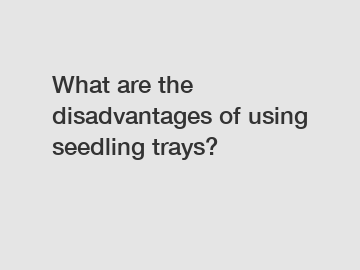What are the disadvantages of using seedling trays?
Seedling trays have been a popular tool for many gardeners and horticulturists around the world, especially for those who want to kick-start their gardening journey or desire to grow a large number of plants efficiently. These trays offer a convenient way to germinate and nurture seedlings until they are ready to be transplanted. However, as with any product or method, there are disadvantages to using seedling trays that shouldn't be overlooked. In this blog, we will explore the downsides of relying solely on seedling trays for your gardening needs.
1. Limited Root Development.
One of the key drawbacks of using seedling trays is that they restrict root growth. Although these trays provide adequate space for initial germination, the confined nature of the compartments eventually inhibits the natural extension of roots. This can lead to stunted growth and weaker plants. When young seedlings are unable to establish robust root systems, they become more vulnerable to stressors like drought, diseases, and pests.

2. Transplant Shock.
Transplanting seedlings from trays to their final growing locations can be a stressful experience for the delicate root systems. Seedlings must adapt to new environmental conditions, including light intensity, temperature, and exposure to elements, which can cause transplant shock or even death for some plants. This risk is higher when seedlings are grown exclusively in seedling trays, as the confined roots have difficulty adapting to the sudden change in growing conditions.
3. Susceptibility to Overwatering and Fungal Infections.
Seedling trays are prone to issues related to excess moisture. As the trays often have limited or no drainage, excess water can accumulate in the compartments, leading to overwatering. Overwatering not only hampers root development due to poor aeration but also promotes the growth of harmful fungi. Fungal diseases like damping-off can spread rapidly in the warm and damp conditions of the trays, significantly reducing seedling survival rates.
4. Time-consuming Maintenance.
While seedling trays streamline the germination process, they require continuous maintenance and care. Seedlings grown in trays require regular monitoring for watering, proper ventilation, and disease prevention. The trays need to be cleaned meticulously to prevent the buildup of mold and bacteria. Additionally, seedlings may require individual attention, such as pruning, thinning, and transplanting, to ensure healthy growth. This constant attention can be demanding, especially for beginner gardeners or those with a busy schedule.
5. Limited Crop Selection.
Seedling trays are most suitable for smaller and more common crops, such as tomatoes, peppers, and lettuce. However, if you wish to grow a wider variety of plants, including larger ones like pumpkins or watermelons, seedling trays may not provide enough space for healthy development. These plants have extensive root systems and require more room for proper growth. By relying solely on seedling trays, you may have to forgo certain plant choices or find alternative methods to start seeds for larger plants, such as soil blocks or direct seeding.
6. Environmental Impact.
While seedling trays can be reused multiple times, they are often made from non-biodegradable materials such as plastic or styrofoam. Improper disposal of these trays can contribute to plastic waste accumulation, further exacerbating environmental issues. Although efforts are being made to develop more sustainable alternatives, the widespread use of disposable seedling trays still poses a challenge to environmental sustainability.
Conclusion.
Seedling trays undoubtedly offer convenience and efficiency in the early stages of plant growth. However, it is crucial to consider the disadvantages associated with their use. Limited root development, transplant shock, moisture-related issues, maintenance demands, restricted crop choices, and environmental concerns all remind us that seedling trays may not be the perfect solution for every gardener or every plant variety. As eco-conscious gardeners, exploring and integrating alternative methods alongside seedling trays can help strike a balance between productivity and sustainability in our gardening practices.
If you are looking for more details, kindly visit bulk seed trays, 128 cell tray, nursery tray.



Comments
0